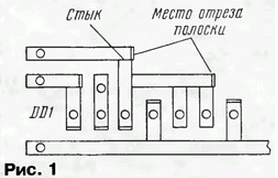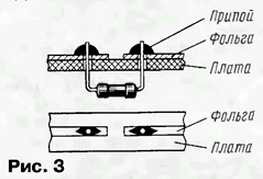The press - by means of an insulating tape. Encyclopedia of radio electronics and electrical engineering

Encyclopedia of radio electronics and electrical engineering / Ham Radio Technologies
 Comments on the article
Comments on the article
There are many ways to draw a pattern of conductors on a foil board. It is difficult to give preference to one of them. Some radio amateurs find it easier to paint conductors with nitro paint, others with photosensitive varnish. However, these methods are complex, time-consuming, require skill, additional devices, and sometimes scarce materials. You can simplify the process with electrical tape - a cheap, affordable material.
The printed circuit board is developed according to the technology recommended in the article by S. Biryukov "Development and manufacture of printed circuit boards" ("Radio", 1996, No. 9, pp. 38-40). After drilling holes for the leads of parts and fixing screws, the board foil is cleaned with fine sandpaper until the burrs disappear.
The next stage is the manufacture of strips of electrical tape, which will lay the future printed conductors. Insulating tape should be polyvinyl chloride (PVC), elastic, as thin as possible, without losing its adhesive properties. When using microcircuits with a pitch between pins of 2,5 mm and a diameter of holes for them on the board of 0,8 ... 1 mm, the optimal width of the strips should be within 1 ... 1,5 mm. Under the conclusions of other parts, the width of the strips should exceed the diameter of the holes by 0,2 ... 0,4 mm.
Strips are cut on a 150x30 mm plate of hard and smooth plastic. A piece of electrical tape is glued onto the plate without stretch, pressing it tightly with your fingers so that there are no bubbles. Using a metal ruler and a cutter (scalpel), cut off the first strip, remove it from the plate and stick it on the board according to the pattern of the printed conductor (Fig. 1).

The excess strip is cut off outside the conductor, holding the strip in this place with a finger. If the conductor is complex, the bend is made at a right angle, gluing the next strip (or the remainder of the previous one) at the bend, cutting it off at the end of the conductor. The laid strip is ironed with a finger for reliable gluing so that the solution does not leak under it during etching.
Subsequent strips are cut and glued to the board in the same way.
Parallel conductors are sealed with strips of electrical tape with a gap between them of 1 ... 1.5 mm. If you do not like the print pattern, the strip (or strips) can be removed and glued more successfully. The place where the strip lay is not cleaned.

If with other methods of manufacturing printed circuit boards, contact pads were made for microcircuit leads (Fig. 2, a), then in this embodiment, their role is played by the elongated ends of printed conductors (Fig. 2, b). As a result, the installation of microcircuits is simplified, since the distance between the lead wires is increased. The same picture is obtained when mounting other parts, say, resistors (Fig. 3).

The contact pads for the conclusions of large parts (oxide capacitors, relays, and others) are sealed with electrical tape in the form of rectangles and squares of various sizes (Fig. 2, c).
Before etching the board, make sure that all holes, except for the mounting holes, are securely covered with electrical tape, there are no gaps in the joints of the strips. In extreme cases, the gaps are closed by gluing additional pieces of tape 3 ... 4 mm long.
After etching, the board is washed with water, the electrical tape is removed, the board is dried, cleaned with fine-grained sandpaper and lubricated with an alcohol-rosin solution. The conductors of the board are covered with a thin layer of solder, after which the board is wiped with alcohol, solvent or acetone and cleaned with newsprint to a mirror shine of the conductors.
Author: Yu.Ivanov
 See other articles Section Ham Radio Technologies.
See other articles Section Ham Radio Technologies.
 Read and write useful comments on this article.
Read and write useful comments on this article.
<< Back
 Latest news of science and technology, new electronics:
Latest news of science and technology, new electronics:
Artificial leather for touch emulation
15.04.2024
In a modern technology world where distance is becoming increasingly commonplace, maintaining connection and a sense of closeness is important. Recent developments in artificial skin by German scientists from Saarland University represent a new era in virtual interactions. German researchers from Saarland University have developed ultra-thin films that can transmit the sensation of touch over a distance. This cutting-edge technology provides new opportunities for virtual communication, especially for those who find themselves far from their loved ones. The ultra-thin films developed by the researchers, just 50 micrometers thick, can be integrated into textiles and worn like a second skin. These films act as sensors that recognize tactile signals from mom or dad, and as actuators that transmit these movements to the baby. Parents' touch to the fabric activates sensors that react to pressure and deform the ultra-thin film. This ... >>
Petgugu Global cat litter
15.04.2024
Taking care of pets can often be a challenge, especially when it comes to keeping your home clean. A new interesting solution from the Petgugu Global startup has been presented, which will make life easier for cat owners and help them keep their home perfectly clean and tidy. Startup Petgugu Global has unveiled a unique cat toilet that can automatically flush feces, keeping your home clean and fresh. This innovative device is equipped with various smart sensors that monitor your pet's toilet activity and activate to automatically clean after use. The device connects to the sewer system and ensures efficient waste removal without the need for intervention from the owner. Additionally, the toilet has a large flushable storage capacity, making it ideal for multi-cat households. The Petgugu cat litter bowl is designed for use with water-soluble litters and offers a range of additional ... >>
The attractiveness of caring men
14.04.2024
The stereotype that women prefer "bad boys" has long been widespread. However, recent research conducted by British scientists from Monash University offers a new perspective on this issue. They looked at how women responded to men's emotional responsibility and willingness to help others. The study's findings could change our understanding of what makes men attractive to women. A study conducted by scientists from Monash University leads to new findings about men's attractiveness to women. In the experiment, women were shown photographs of men with brief stories about their behavior in various situations, including their reaction to an encounter with a homeless person. Some of the men ignored the homeless man, while others helped him, such as buying him food. A study found that men who showed empathy and kindness were more attractive to women compared to men who showed empathy and kindness. ... >>
 Random news from the Archive Random news from the Archive Efficient molecular diodes
06.07.2017
An international team of scientists from the United States, Ireland and Singapore, led by Professor Christian A. Nijhuis of the National University of Singapore, has for the first time been able to create efficient molecular rectifier diodes.
Diodes are electronic elements that have different conductivity depending on the direction in which current flows through them. Rectifier diodes convert AC to DC; their main characteristic is the rectification factor K, equal to the ratio of the values of the alternating voltage at the input and the rectified voltage at the output.
For modern industrial silicon rectifier diodes, K values vary from 105 to 108. However, for molecular diodes - molecular-scale elements that could theoretically be used to create superminiature electronic devices - this figure has so far been, at best, 103, which is clearly not enough.
Now Nijuys and his colleagues have succeeded in creating a molecular diode with a rectification factor of 6.3x105. These are macroscale tunnel transitions based on a single layer of molecular diodes. The number of molecules conducting current in these junctions varies with bias polarity, thereby multiplying the internal rectification factor of an individual molecule by three orders of magnitude.
"This exceeds the theoretical limit," commented Professor Enrique del Barco of the University of Central Florida, one of the paper's co-authors. "Now we have a molecular diode comparable in performance to silicon. What was a theoretical scientific model is moving into the plane of commercial possibilities.
However, for now, molecular diodes, apparently, will not replace completely electronic ones - but they may be able to replace them in some areas. One of their advantages is low cost and ease of production, because molecular diodes can be synthesized directly in the laboratory.
|
 Other interesting news:
Other interesting news:
▪ Outboard motor for wheelchair
▪ First linen fabric
▪ Axis Vidius - the smallest drone with a camera
▪ Ultra-fast FRAME camera
▪ Hair coloring using champignon enzyme
 News feed of science and technology, new electronics
News feed of science and technology, new electronics
 Interesting materials of the Free Technical Library:
Interesting materials of the Free Technical Library:
▪ section of the site Household electrical appliances. Selection of articles
▪ article Believe it or not. Popular expression
▪ article Which chips were unsuccessfully demanded by their company not to be considered chips? Detailed answer
▪ Iglits article. Legends, cultivation, methods of application
▪ article High-voltage power supply (for Chizhevsky's chandelier). Encyclopedia of radio electronics and electrical engineering
▪ article Transformerless charger, 20 volts 140 milliamps. Encyclopedia of radio electronics and electrical engineering
 Leave your comment on this article:
Leave your comment on this article:
 All languages of this page
All languages of this page
Home page | Library | Articles | Website map | Site Reviews

www.diagram.com.ua
2000-2024







 Arabic
Arabic Bengali
Bengali Chinese
Chinese English
English French
French German
German Hebrew
Hebrew Hindi
Hindi Italian
Italian Japanese
Japanese Korean
Korean Malay
Malay Polish
Polish Portuguese
Portuguese Spanish
Spanish Turkish
Turkish Ukrainian
Ukrainian Vietnamese
Vietnamese



 Leave your comment on this article:
Leave your comment on this article: